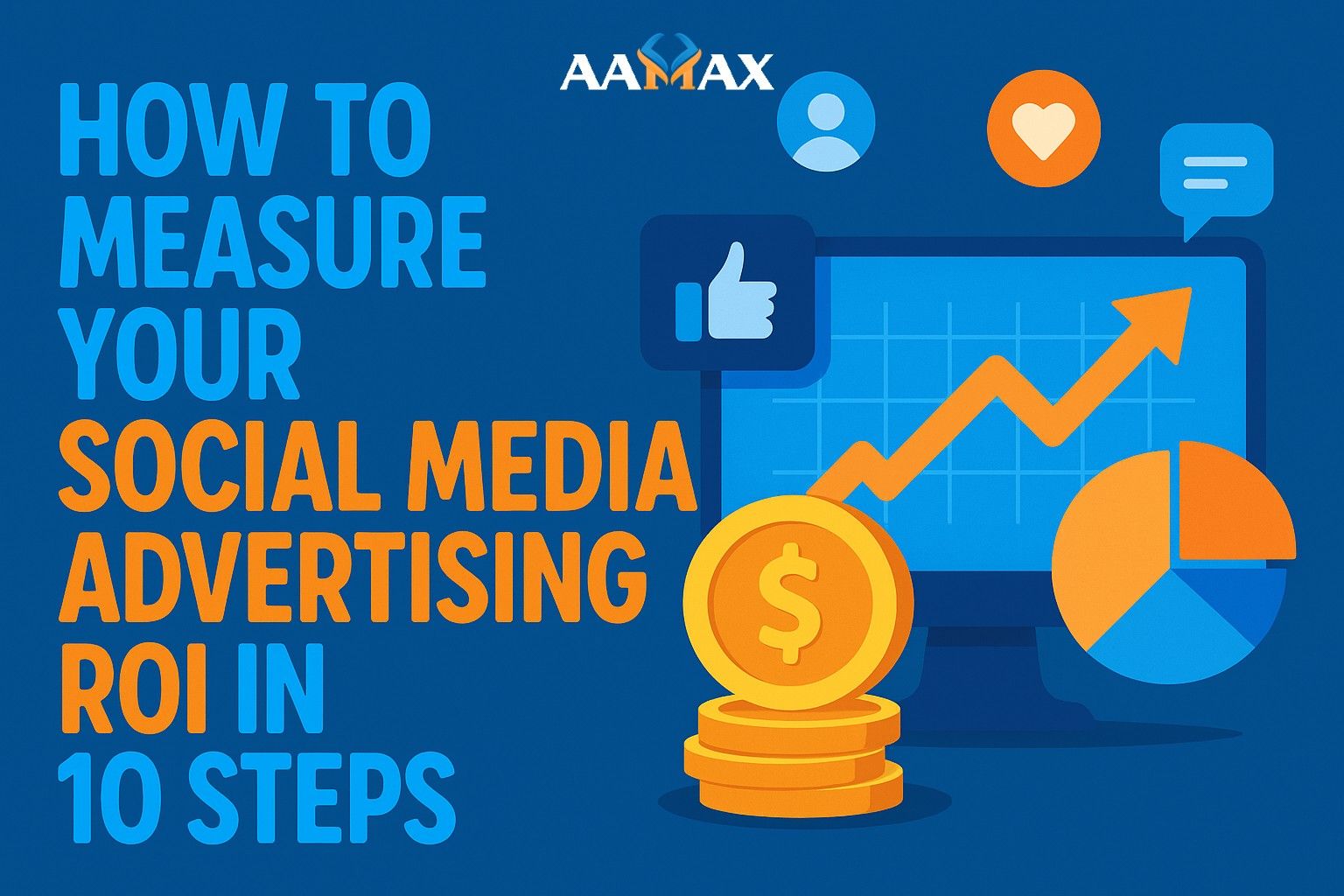
How to Measure Your Social Media Advertising ROI in 10 Steps
In today’s digital-first world, social media advertising plays a crucial role in building brand awareness, generating leads, and driving revenue. However, simply investing in social media ads isn’t enough—you need to know whether your investment is delivering real value. Measuring ROI (Return on Investment) from social media advertising helps marketers determine the success of campaigns and refine their strategies for better results.
This guide breaks down the process into full-service digital marketing agency to help you measure your social media advertising ROI effectively.
What Is Social Media Advertising ROI?
Social media advertising ROI is a metric that shows the profit or loss generated by your social media ad campaigns relative to the amount of money you spent. It tells you whether your ads are truly contributing to your business objectives such as increased sales, leads, or brand engagement.
ROI Formula:
ROI = (Revenue from Ads – Cost of Ads) / Cost of Ads × 100
For example, if you made $10,000 from a campaign that cost you $2,000, your ROI is:
($10,000 - $2,000) / $2,000 × 100 = 400%
Now, let’s explore the 10 steps to measure this ROI accurately.
Step 1: Define Clear Goals and KPIs
Before launching any campaign, clearly define what success looks like. Ask yourself:
- Do you want sales, leads, website visits, or brand awareness?
- What are your Key Performance Indicators (KPIs)?
Examples of KPIs:
- Conversion rate
- Cost per acquisition (CPA)
- Click-through rate (CTR)
- Engagement rate
- Revenue generated
Align your goals with measurable outcomes to make ROI tracking easier.
Step 2: Set Up Tracking Mechanisms
To accurately measure ROI, you must track user behavior from ad click to conversion.
Here’s what to do:
- Install Meta Pixel (for Facebook and Instagram) or TikTok Pixel, LinkedIn Insight Tag, etc.
- Use Google Tag Manager to organize and manage all your tracking tags.
- Enable conversion tracking for specific events like purchases, form submissions, or app installs.
This data allows platforms to report back how many conversions were directly attributed to your ads.
Step 3: Use UTM Parameters for Campaign Tracking
UTM (Urchin Tracking Module) parameters are snippets you add to URLs in your ads to track their performance in Google Analytics or similar platforms.
Example URL with UTM:
https://example.com/landing-page?utm_source=facebook&utm_medium=cpc&utm_campaign=summer_sale
Use UTM parameters to track:
- Traffic source
- Ad campaign
- Audience segment
Google’s free Campaign URL Builder can help you generate UTMs easily.
Step 4: Assign Monetary Values to Conversions
To calculate ROI, assign actual dollar values to conversions. Some examples:
- If you sell a product for $100, that’s the value per purchase.
- If a lead typically converts into a $500 sale with a 10% closing rate, the lead value is $50.
Understanding the customer lifetime value (CLV) also helps in assigning values to long-term conversions.
Step 5: Consolidate Data from Different Platforms
Social media campaigns often run across multiple platforms: Facebook, Instagram, TikTok, LinkedIn, Twitter (X), and Pinterest.
Use tools to bring all your ad performance data into one dashboard:
- Google Analytics
- Supermetrics
- Data Studio (Looker Studio)
- Hootsuite or Sprout Social
- Native ad managers (e.g., Meta Ads Manager, TikTok Ads Manager)
This helps identify which channels drive the best ROI.
Step 6: Analyze Ad Spend vs. Revenue
Track how much you’re spending on each ad and how much revenue it brings in.
Break this down by:
- Campaign
- Ad group
- Individual ad
- Target audience
This will help you discover what’s working and what’s draining your budget. For example, a campaign might have high engagement but low sales—indicating a need for better targeting or messaging.
Step 7: Calculate ROI Using the Right Formula
Use the standard ROI formula but apply it carefully:
ROI = (Revenue – Cost) / Cost × 100
Let’s say:
- Ad Spend = $5,000
- Revenue = $20,000
Then,
ROI = ($20,000 - $5,000) / $5,000 × 100 = 300%
You can also calculate ROAS (Return on Ad Spend), which is simpler:
ROAS = Revenue / Cost
A ROAS of 4.0 means you earned $4 for every $1 spent.
Step 8: Factor in Indirect Value
Not all ROI is direct. Some benefits are intangible or long-term:
- Follower growth
- Brand visibility
- Word-of-mouth
- Email signups
- Repeat purchases
Use multi-touch attribution models to assign value to different touchpoints in the buyer journey. Google Analytics 4 and other tools can help with attribution modeling.
Step 9: Evaluate and Compare Campaigns Over Time
Social media ROI should be evaluated regularly—weekly, monthly, quarterly—to identify trends.
Compare:
- Paid campaigns vs. organic reach
- This month vs. last month
- Campaign A vs. Campaign B
This comparison shows whether your ROI is improving and where to shift your budget.
Create custom dashboards to visualize trends over time. These insights are invaluable for strategic planning.
Step 10: Optimize and Scale Successful Campaigns
Once you’ve identified which ads drive the best ROI, it’s time to optimize.
Do more of what works:
- Increase budget for high-performing campaigns
- Use A/B testing to refine headlines, visuals, CTAs
- Adjust targeting to reach lookalike audiences
Stop or rework campaigns with poor ROI.
Consistent optimization can improve ROI by 30–50% over time.
Bonus: Work With Experts to Maximize ROI
Measuring and optimizing ROI from social media advertising can be overwhelming without the right expertise, tools, and experience. That's why businesses often turn to professionals.
Consider partnering with a full-service digital marketing agency like AAMAX.
AAMAX provides:
- Expert social media strategy and ad management
- Advanced analytics and ROI tracking
- Conversion rate optimization
- SEO and content marketing
- Web development for landing pages that convert
Their integrated approach ensures your ad spend delivers maximum return—whether you're a startup or scaling enterprise.
Final Thoughts
Measuring your social media advertising ROI is not just about crunching numbers—it’s about using data to make smarter marketing decisions. When done right, ROI tracking can lead to greater profitability, improved customer targeting, and sustainable growth.
To recap, here are the 10 steps:
- Define goals and KPIs
- Set up tracking
- Use UTM parameters
- Assign values to conversions
- Consolidate data
- Compare ad spend and revenue
- Calculate ROI
- Include indirect benefits
- Evaluate campaigns
- Optimize and scale
Each step plays a crucial role in understanding what you get in return for your ad investment.
If you’re ready to take the guesswork out of ROI and drive results with confidence, it’s time to get professional support. Hire AAMAX and unlock the full potential of your social media advertising.







